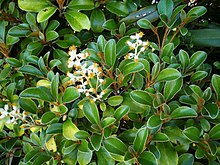
Soursop is the fruit of Annona muricata, a broadleaf, flowering, evergreen tree. The exact origin is unknown; it is native to the tropical regions of the Americas and the Caribbean and is widely propagated. It is in the same genus, Annona, as cherimoya and is in the Annonaceae family.

The rifleman is a small insectivorous passerine bird that is endemic to New Zealand. It belongs to the family Acanthisittidae, also known as the New Zealand wrens, of which it is one of only two surviving species. The rifleman resembles a wren in form, but is not related to the family of true wrens, Troglodytidae, nor the fairy-wrens of Australia.
The large forest bat is a vespertilionid bat found in southeast Australia, Tasmania, and Lord Howe Island. They are classified as common.

Brachyglottis is a genus of flowering plants in the aster family, Asteraceae. The genus was erected on November 29, 1775, by Johann Reinhold Forster and Georg Forster. The name was derived from the Greek brachus ("short") and glottis a reference to the size of the ray florets.
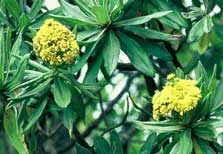
Brachyglottis huntii, commonly called Rautini or Chatham Island Christmas tree, is a species of flowering plant in the family Asteraceae. It is found only on the Chatham Islands in New Zealand.

Cordyline obtecta is a widely branching monocot tree native to Norfolk Island, and to northern New Zealand. The species name obtecta derives from the Latin obtegere, alluding to the way the inflorescence barely protruded beyond the leaves in the plant first described.
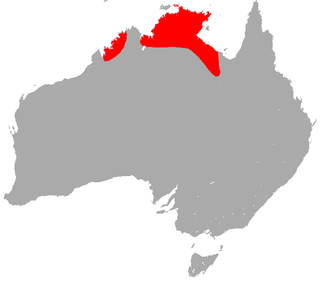
The northern leaf-nosed bat is a micro-bat of the family Hipposideridae, known as "leaf-nosed" bats. The species is endemic to northern regions of Australia. They are highly manoeuvrable in flight, and use echolocation to forage for insect prey.
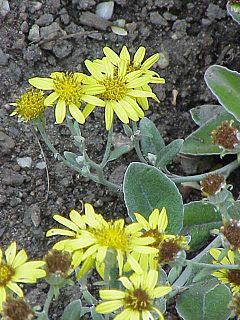
Brachyglottis greyi, commonly known as daisy bush, is a member of the large family Asteraceae and belongs to the genus Brachyglottis or the genus Senecio depending on which authority is being followed, an endemic native of New Zealand and lately getting positive attention from gardeners.

Senecio angulatus, also known as creeping groundsel and sometimes as Cape ivy, is a succulent plant from the family Asteraceae of the genus Senecio that is native to South Africa. It is a scrambling and a twining herb that can become an aggressive weed once established, making it an invasive species in some countries. However, it is grown as an ornamental plant for its satiny foliage and sweet-scented flowers.

Epyaxa rosearia, the New Zealand looper or plantain moth, is a moth of the family Geometridae. It is endemic to New Zealand.

Celmisia spectabilis is one of the more widespread species in the mountainous areas of New Zealand, where it is commonly known as the cotton daisy. Belonging to the family Asteraceae, this species has leathery leaves that are ovate to lanceolate or narrowly oblong, and can reach 30 cm long. They have a shiny, green upper surface, with prominent parallel grooves, but their undersides are densely covered in soft, whitish or buff-coloured hairs. The leaf bases overlap and compact to form a stout pseudostem. Plants can form mats up to 2 m across.

Psilocybe makarorae is a species of psilocybin mushroom in the family Hymenogastraceae. Officially described as new to science in 1995, it is known only from New Zealand, where it grows on rotting wood and twigs of southern beeches. The fruit body (mushroom) has a brownish cap with lighter coloured margins, measuring up to 3.5 cm (1.4 in) wide. The cap shape is either conical, bell-shaped, or flat depending on the age of the mushroom, and it features a prominent umbo. Although the whitish stem does not form a true ring, it retains remnants of the partial veil that covers and protects the gills of young fruit bodies. P. makarorae mushrooms can be distinguished from the similar North American species Psilocybe caerulipes by microscopic characteristics such as the presence of cystidia on the gill faces (pleurocystidia), and cheilocystidia with more elongated necks. Based on the bluing reaction to injury, P. makarorae is presumed to contain the psychedelic compounds psilocybin and psilocin.

The Northland temperate forests, also known as the North Island temperate forests, is a temperate broadleaf and mixed forests ecoregion on New Zealand’s North Island.
Sabatinca calliarcha is a species of moth belonging to the family Micropterigidae. It was described by Edward Meyrick in 1912. It is known from New Zealand.
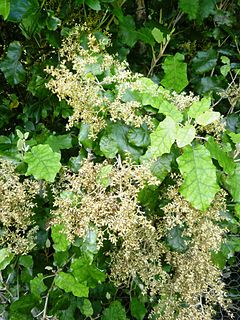
Brachyglottis repanda is a small, bushy tree or tall shrub endemic to New Zealand. It grows to a height of 5 to 7 meters. The petioles of the leaves have a characteristic groove up to 10 cm long. The large leaves with a soft furry underside have been referred to as "bushman's toilet paper".
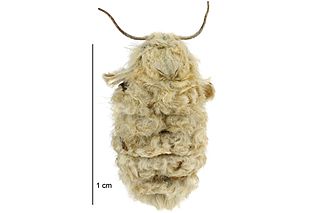
Metacrias erichrysa is a species of moth of the family Erebidae. It is endemic to New Zealand. This species can be found in the lower half of the North Island and western alpine areas of the South Island. The female of the species is flightless and buff coloured whereas the male is brightly coloured and a rapid flier.

Hellinsia inquinatus is a moth of the family Pterophoridae. It is found in North America, including Florida, Mississippi, Oklahoma, Tennessee, Maryland, Alabama, Texas, Missouri, Colorado and Arizona. It has also been recorded from Hispaniola, Mexico, Puerto Rico and St. Thomas Island.
Hellinsia cochise is a moth of the family Pterophoridae that is found in Arizona. The species was first described by William Barnes and Arthur Ward Lindsey in 1921.
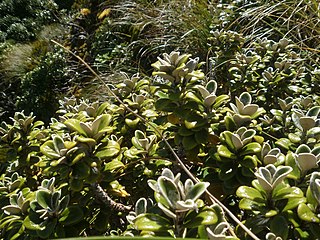
Brachyglottis bidwillii is a species of flowering plant in the family Asteraceae. It is endemic to New Zealand.

Oplismenus hirtellus is a flowering perennial plant from the family Poaceae that can be found on every continent in the world except Antarctica, growing mostly in coastal tropic and subtropic regions as well as tropical and subtropical islands such as Hawaii, New Zealand, Australia and Madagascar.
